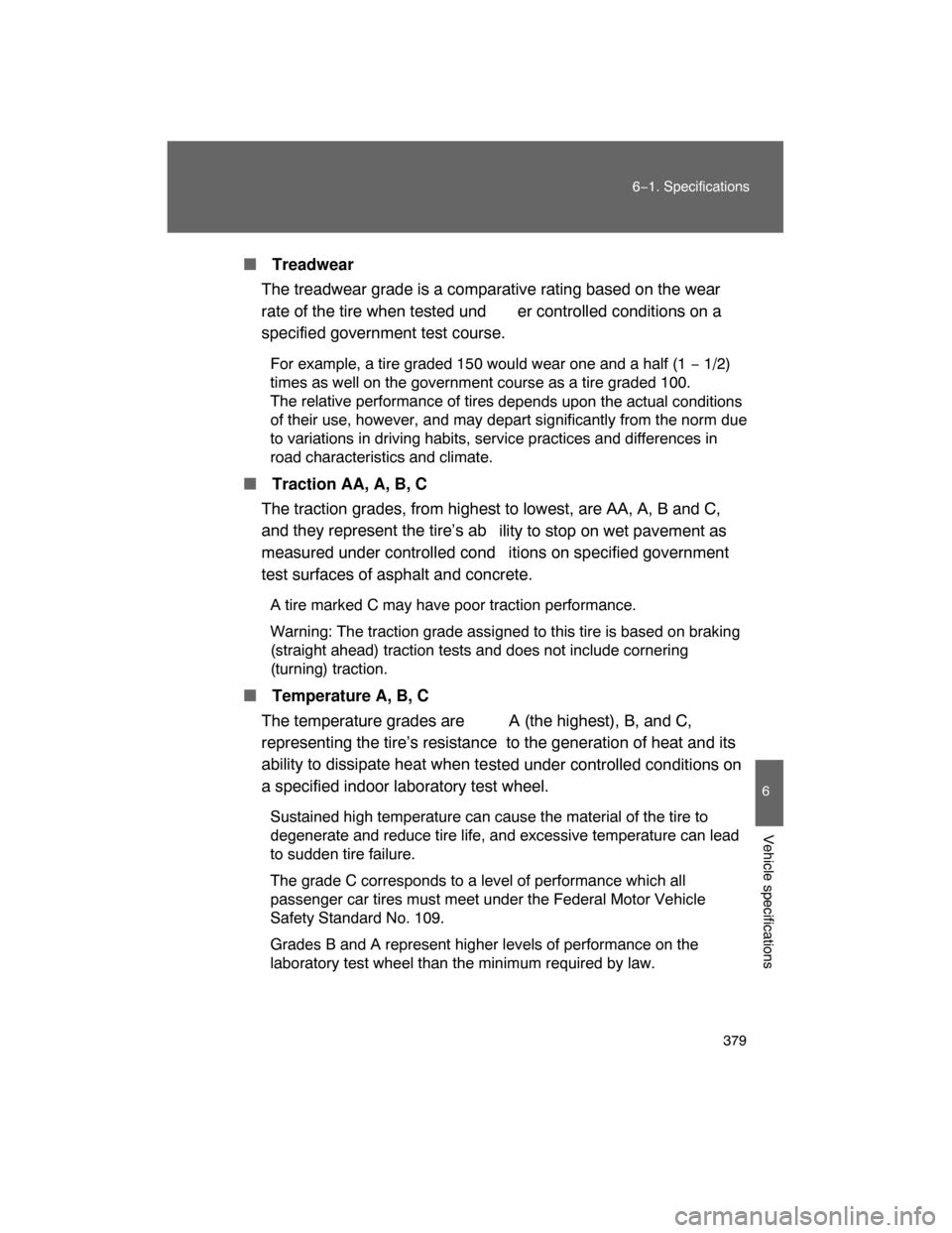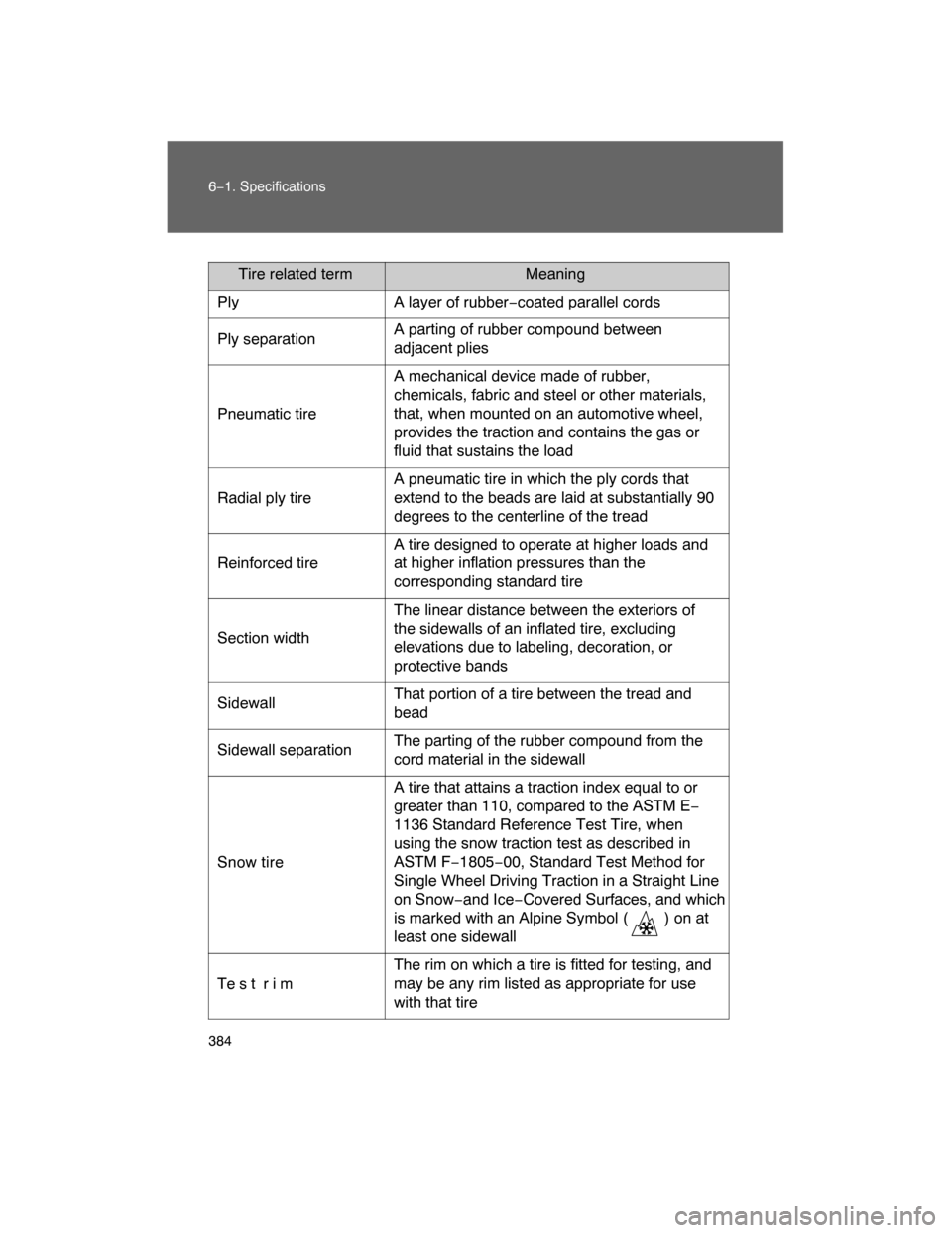Page 355 of 400
360 5−2. Steps to take in an emergency
CAUTION
� When attempting to free a stuck vehicle
If you choose to rock the vehicle back and forth to free it, make sure the sur−
rounding area is clear, to avoid striki
ng other vehicles, objects or persons.
The vehicle may also lunge forward or lunge back suddenly as it becomes
free. Use extreme caution.
� When shifting the shift lever
Vehicles with automatic transmission: Be careful not to shift the shift lever
with the accelerator pedal depressed.
This may lead to unexpected rapid acceleration of the vehicle that may
cause an accident and result in death or serious injury.
NOTICE
� To avoid damaging the transmission and other components
� Avoid spinning the wheels and do not rev the engine.
�
If the vehicle remains stuck after trying these procedures, the vehicle may
require towing to be freed.
Page 356 of 400
362
6−1. Specifications
Maintenance data (fuel, oil level, etc.)
Dimensions and weight
*: Unladen vehicle
Overall length 183.9 in. (4670 mm)
Overall width 75.0 in. (1905 mm)
Overall
height*2WD models 71.3 in. (1810 mm)
4WD models 72.0 in. (1830 mm)
Wheelbase 105.9 in. (2690 mm)
Front tread 63.2 in. (1605 mm)
Rear tread 63.2 in. (1605 mm)
Vehicle capacity weight
(Occupants + luggage)
1190 lb. (540 kg)
Towing capacity
(Trailer weight + cargo)
5000 lb. (2265 kg)
Page 364 of 400
370 6−1. Specifications
Tires and wheels
Tire size P265/75R16 114T, P265/70R17 113S
Tire inflation pressure
(Recommended cold tire
inflation pressure)Front tires:
32 psi (220 kPa, 2.2 kgf/cm
2 or bar)
Rear tires:
32 psi (220 kPa, 2.2 kgf/cm
2 or bar)
Spare tire:
32 psi (220 kPa, 2.2 kgf/cm
2 or bar)
Wheel size 16 7 J, 17
7 1/2 J
Wheel nut torque 85 ft⋅lbf (113 N⋅m, 11.5 kgf⋅m)
Page 371 of 400
377
6−1. Specifications
6
Vehicle specifications
Tire size
� Typical tire size information
The illustration indicates typical
tire size.
Ti r e u s e
(P = Passenger car,
T = Temporary use)
Section width (millimeters)
Aspect ratio
(tire height to section width)
Tire construction code
(R = Radial, D = Diagonal)
Wheel diameter (inches)
Load index (2 digits or 3 digits)
Speed symbol
(alphabet with one letter)
� Tire dimensions
Section width
Tire height
Wheel diameter
Page 373 of 400

379
6−1. Specifications
6
Vehicle specifications
� Treadwear
The treadwear grade is a comparative rating based on the wear
rate of the tire when tested und
er controlled conditions on a
specified government test course.
For example, a tire graded 150 would wear one and a half (1 − 1/2)
times as well on the government course as a tire graded 100.
The relative performance of tires
depends upon the actual conditions
of their use, however, and may depart significantly from the norm due
to variations in driving habits, service practices and differences in
road characteristics and climate.
� Traction AA, A, B, C
The traction grades, from highest to lowest, are AA, A, B and C,
and they represent the tire’s ab
ility to stop on wet pavement as
measured under controlled cond itions on specified government
test surfaces of asphalt and concrete.
A tire marked C may have poor traction performance.
Warning: The traction grade assigned to this tire is based on braking
(straight ahead) traction tests and does not include cornering
(turning) traction.
� Temperature A, B, C
The temperature grades are A (the highest), B, and C,
representing the tire’s resistance to the generation of heat and its
ability to dissipate heat when te
sted under controlled conditions on
a specified indoor laboratory test wheel.
Sustained high temperature can cause the material of the tire to
degenerate and reduce tire life, and excessive temperature can lead
to sudden tire failure.
The grade C corresponds to a level of performance which all
passenger car tires must meet under the Federal Motor Vehicle
Safety Standard No. 109.
Grades B and A represent higher levels of performance on the
laboratory test wheel than the minimum required by law.
Page 375 of 400

381
6−1. Specifications
6
Vehicle specifications
Tire related term Meaning
Normal occupant
weight150 lb. (68 kg) times the number of occupants
specified in the second column of Table 1
* that
follows
Occupant distributionDistribution of occupants in a vehicle as
specified in the third column of Table 1
* below
Production options
weightThe combined weight of installed regular
production options weighing over 5 lb. (2.3 kg)
in excess of the standard items which they
replace, not previously considered in curb
weight or accessory weight, including heavy
duty brakes, ride levelers, roof rack, heavy duty
battery, and special trim
RimA metal support for a tire or a tire and tube
assembly upon which the tire beads are seated
Rim diameter
(Wheel diameter)Nominal diameter of the bead seat
Rim size designation Rim diameter and width
Rim type designationThe industry manufacturer’s designation for a
rim by style or code
Rim width Nominal distance between rim flanges
Vehicle capacity
weight (Total load
capacity)The rated cargo and luggage load plus 150 lb.
(68 kg) times the vehicle’s designated seating
capacity
Vehicle maximum load
on the tireThe load on an individual tire that is determined
by distributing to each axle its share of the
maximum loaded vehicle weight, and dividing
by two
Vehicle normal load
on the tireThe load on an individual tire that is determined
by distributing to each axle its share of curb
weight, accessory weight, and normal
occupant weight (distr
ibuted in accordance
with Table 1
* below), and dividing it by two
Page 378 of 400

384 6−1. Specifications
Tire related term Meaning
Ply A layer of rubber−coated parallel cords
Ply separationA parting of rubber compound between
adjacent plies
Pneumatic tireA mechanical device made of rubber,
chemicals, fabric and steel or other materials,
that, when mounted on an automotive wheel,
provides the traction and contains the gas or
fluid that sustains the load
Radial ply tireA pneumatic tire in which the ply cords that
extend to the beads are laid at substantially 90
degrees to the centerline of the tread
Reinforced tireA tire designed to operate at higher loads and
at higher inflation pressures than the
corresponding standard tire
Section widthThe linear distance between the exteriors of
the sidewalls of an inflated tire, excluding
elevations due to labeling, decoration, or
protective bands
SidewallThat portion of a tire between the tread and
bead
Sidewall separationThe parting of the rubber compound from the
cord material in the sidewall
Snow tireA tire that attains a traction index equal to or
greater than 110, compared to the ASTM E−
1136 Standard Reference Test Tire, when
using the snow traction test as described in
ASTM F−1805−00, Standard Test Method for
Single Wheel Driving Traction in a Straight Line
on Snow−and Ice−Covered Surfaces, and which
is marked with an Alpine Symbol ( ) on at
least one sidewall
Te s t r i mThe rim on which a tire is fitted for testing, and
may be any rim listed as appropriate for use
with that tire
Page 379 of 400

385
6−1. Specifications
6
Vehicle specifications
*:Table 1 Occupant loading and distri bution for vehicle normal load
for various designated seating capacities
Tire related term Meaning
Tr ea dThat portion of a tire that comes into contact
with the road
Tread ribA tread section running circumferentially
around a tire
Tread separation Pulling away of the tread from the tire carcass
Treadwear
indicators(TWI)
The projections within the principal grooves
designed to give a visual indication of the
degrees of wear of the tread
Wheel−holding fixtureThe fixture used to hold the wheel and tire
assembly securely
during testing
Designated seating
capacity, Number of
occupants
Vehicle normal load,
Number of occupantsOccupant distribution
in a normally loaded
vehicle
2 through 4 2 2 in front
5 through 10 32 in front, 1 in second
seat
11 through 15 52 in front, 1 in second
seat, 1 in third seat, 1
in fourth seat
16 through 20 72 in front, 2 in second
seat, 2 in third seat, 1
in fourth seat